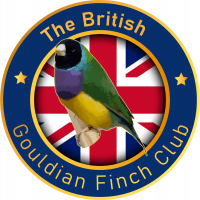Featured image by Alwyn Simple
Although commonly known today as simply the Gouldian finch, this bird was first named “The Lady Gouldian Finch” in 1845 by an ornithologist called John Gould. Like most of us, if not all who first lay eyes upon this finch, John Gould was so struck by its beauty that he dedicated the naming of this finch to the memory of his late wife.
The Gouldian finch is a small seed eating bird, about 5” in size from tip to tail, and belongs to the family of birds known as Estrildidae. Native to Australia, the finch’s natural habitat ranges across the country’s northern belt, which includes Kimberly to the west, the Northern territory, and the northern parts of Queensland. Although they were once more prominent in numbers this is no longer the case and the 20th century saw a rapid decline in the numbers of these wild birds. With today’s wild population estimated to be less than 2500 adult birds remaining, the finch is now recognised globally as a near threatened species.
In the earlier years of the Gouldian finches discovery it was unknown if the colour variations were of the same species or of different species. The three naturally occurring colours in the wild include the black headed, the red headed and the Yellow head, although the yellow head actually appears more orange in colour. Both genders of the Gouldian finch can occur in these 3 different head colours.
In the finches’ natural habitat the black head is the most common variety at around 70% of the population. The red head population is at around 30% while the yellow heads are very rare and are thought to only make up about 1 bird in every thousand. Today the naturally occurring different head colours of this finch are understood to be morphs of the same species. It is believed that the change in climates over many generations forced the Gouldian finches’ ancestral bird into the three separate most northern tips of Australia, one in Western Australia, one in the Northern Territory and one in the peninsula of Queensland.
With these 3 populations now separated from each other, different forms (head colours) evolved in isolation from one another. But as the climate became wetter, and the savannah habitat expanded southwards, so did these three different populations of birds. The newly expanded savannah now put the black, red and yellow headed Gouldian finches back into contact with one another. These three different head colour morphs of the Gouldian finch shows us quite remarkably how a species evolves over extended periods of time.
Captive bred Gouldian finches have an average life expectancy of 5 to 6. It is not uncommon however for birds that are well cared for to live beyond this age and I have personally experienced a couple of my birds live up to 9 years of age. The wild Gouldian finches’ life expectancy is much shorter, this is attributed to the hardships of surviving predators, lack of food availability during the tougher months, and droughts. This is the higher price wild Gouldian finches will pay for living in their natural environment compared to their captive bred cousins who (if looked after properly) can enjoy more creature comforts throughout their longer lives.
The Gouldian finch is a relatively easy bird to sex. The primary visual indicator to look for when sexing this finch is the cock bird is much brighter in colour and the hen is more pastel in her tones. This is most noticeable upon the finches’ breast, where the cock has more of a medium to dark purple colouring and the hen has a more pink to light purple colouring. Other indicators include the cock bird having a much more defined and brighter blue colour than the hen as well as a longer tail. With the red and yellow head coloured birds the cock has a noticeably brighter facial mask than the hen.
The Gouldian finch can also be sexed vocally. Both birds have a series of tweets and sounds they use to express themselves but it is only the cock bird who sings. Some cock birds have a much more beautiful and flowing song than other cock birds do, but regardless of the bird’s singing ability it is relatively easy to identify a Gouldian finches’ song from the tweets and whistles it makes.
There are several Gouldian finch mutations that are known throughout aviculture today. The most common being the white breasted variety. Aside from the lack of any colour pigmentation on the birds breast the bird appears otherwise normal in its plumage. This mutation can occur in either sex. Other known mutations include the silver, the dilute, the yellow back and the blue. Some of the Gouldian finch mutations are easier to sex than others but all can still be sexed either visually or vocally.
This article was written by Paul Bancroft @ PlanetAviary.com , thanks for letting the club use this informative article.
Please check out PlanetAviary






